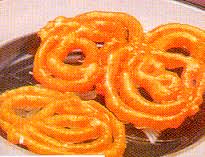Jalebi is the National Sweet of India
 Jalebi is the National Sweet of India, so here is Jalebi served on Independence day.Jalebi is a sweet commonly sold in India, Pakistan and Bangladesh. Jalebi is thought to have originated in the North of India, probably in the state of Punjab. The Persian word for Jalebi is “Zoolbiah”. It is made from deep-fried, syrup-soaked batter and shaped into a large, chaotic pretzel shape, rather like the American funnel cake. Jalebis are mostly bright orange in colour but are also available in white. It can be served dripping warm or cold. It has a somewhat chewy texture with a crystallised sugary crunch. The sugars get partly fermented which is thought to add flavour to the dish. Jalebi is sold at Halwai shops and at traditional sub continental sweet shops. The southern Indian look alike is jangiri. Along with Jalebi Another version of it, “Emarti” is red-orange in colour and sweeter in taste from the Indian state of Uttar Pradesh.
Jalebi is the National Sweet of India, so here is Jalebi served on Independence day.Jalebi is a sweet commonly sold in India, Pakistan and Bangladesh. Jalebi is thought to have originated in the North of India, probably in the state of Punjab. The Persian word for Jalebi is “Zoolbiah”. It is made from deep-fried, syrup-soaked batter and shaped into a large, chaotic pretzel shape, rather like the American funnel cake. Jalebis are mostly bright orange in colour but are also available in white. It can be served dripping warm or cold. It has a somewhat chewy texture with a crystallised sugary crunch. The sugars get partly fermented which is thought to add flavour to the dish. Jalebi is sold at Halwai shops and at traditional sub continental sweet shops. The southern Indian look alike is jangiri. Along with Jalebi Another version of it, “Emarti” is red-orange in colour and sweeter in taste from the Indian state of Uttar Pradesh.
Jalebi is one of the most popular sweets in India and is served as the ” National Sweet of India ” especially during the National holidays like Independence Day and Republic Day in the government offices and defence installations.
Jalebi’s colours are bright orange or yellow, but also white. They are from North India. They are best to eat when they are fresh. It can be served when it is warm or cold. Rajasthani jalebis are slightly thicker and fried to a brown colour. Gujarati jalebis are yellow in colour. They have fragrant with kesar and a cut above. To prepare jalebi sugar syrup is needed.
The earliest written references to the sweet are found in a 13th century cookbook by Muhammad bin Hasan al-Baghdadi. In Iran, where it is known as Zlebia, the sweet was traditionally given to the poor during Ramadan.It likely arrived in the Indian subcontinent during the period of Muslim rule, through cultural diffusion and trade, and its local name is Jalebi as Z is replaced by J in most Indian languages.One of the earliest known Indian references for the sweet exists in a Jain work — Priyamkarnrpakatha — by Jinasura, apparently composed in AD 1450. This work was subsequently cited in cookery books published in later centuries including the 17th-century classic Bhojan-kutuhala by Raghunatha.